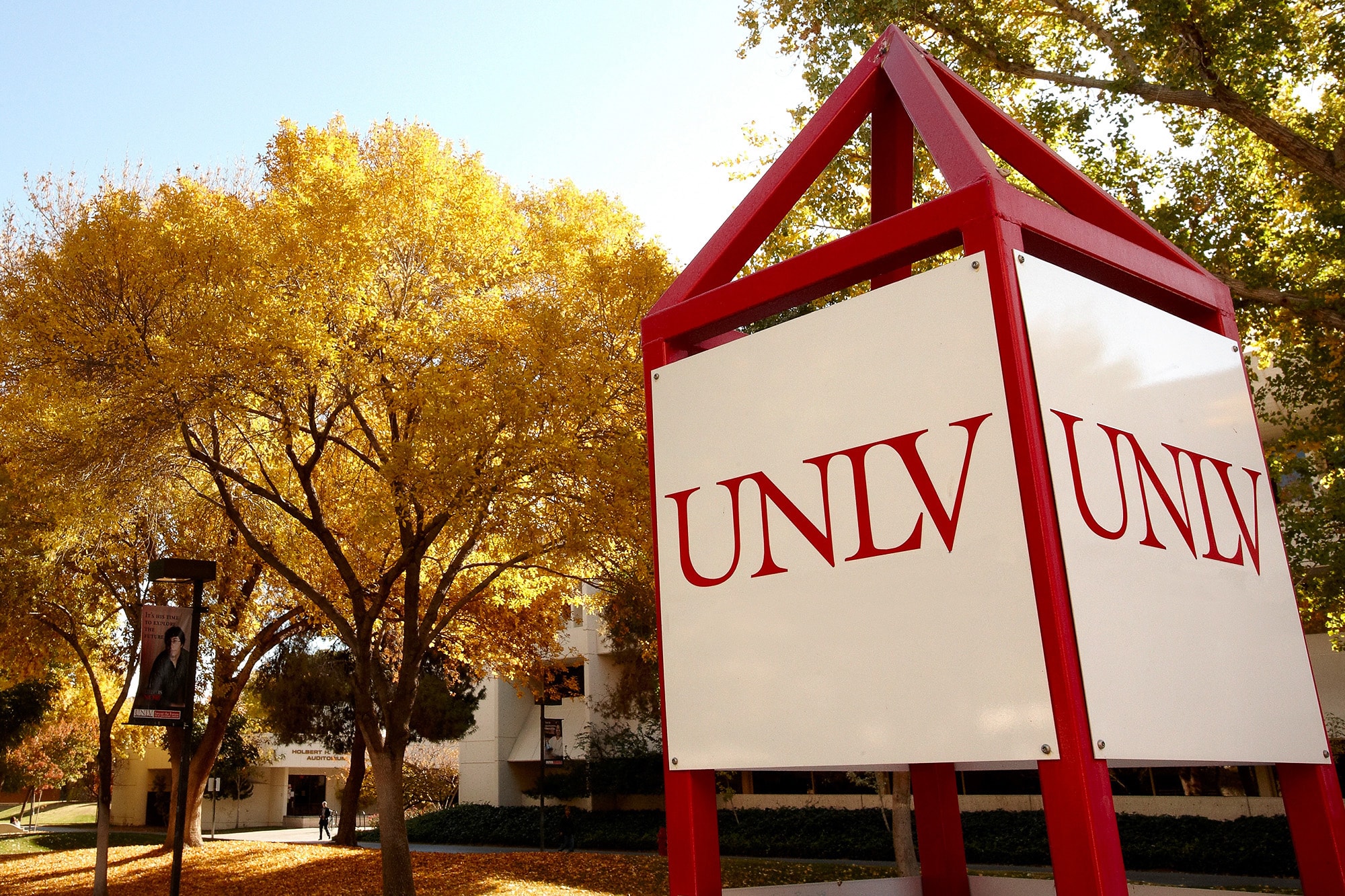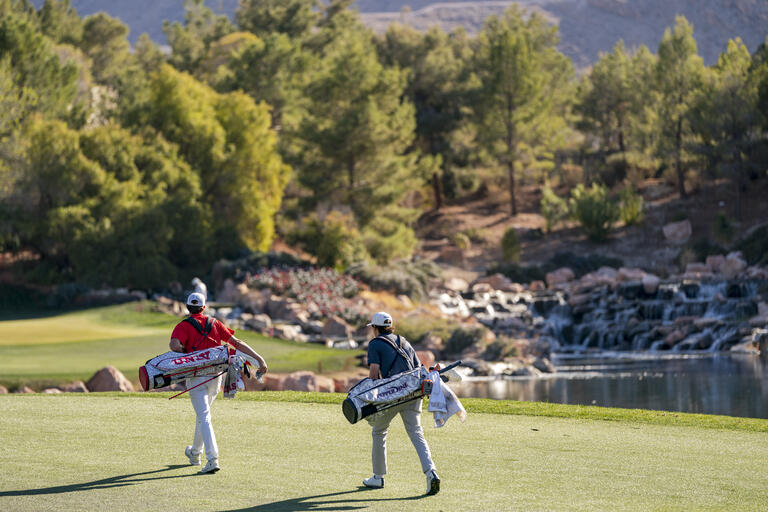Nursing professor Barbara St. Pierre Schneider and her team are conducting research that may lead to new therapies to expedite muscle recovery and reduce rehabilitation time after injury.
But her project–which focuses on how microscopic immune cells called macrophages contribute to muscle injury repair–might not be under way today had it not been for a UNLV initiative introduced to encourage collaborative research projects.
“I was relatively new to the university when I conceived the idea for this project,” says St. Pierre Schneider. “It was a wonderful idea, but I didn’t have a research team or the funding to pursue it at the time.”
Soon after, she learned of the availability of the President’s Research Award (PRA), a source of internal funding being offered to support collaborative research teams and encourage the acquisition of external grants. As news of the award program spread, St. Pierre Schneider found others who shared her interest; they applied for and received one of 11 PRAs awarded last spring.
The PRA is one of several initiatives established by UNLV President David Ashley to promote research, scholarship, and creative activity.
“We have created several internal awards programs and allocated additional travel funds to support these endeavors,” Ashley says. “Through the President’s Research Award, we are seeking to encourage collaborative projects that have a strong likelihood of realizing competitive grant funding. The acquisition of such funding will enable faculty to advance their research further and will benefit the university in many ways.”
For St. Pierre Schneider and her collaborators–public health professor Sheniz Moonie and Patricia Bray-Ward from the Division of Research and Graduate Studies–the $50,000 they received through the PRA program has provided the extra impetus they needed to take their project to the next level.
St. Pierre Schneider and her team are already using their PRA to gather preliminary data to support two grant proposals they plan to submit to federal agencies.
Ten other UNLV research teams received funding up to $50,000 and are using their funding similarly: to seek competitive grants that will enable them to pursue their research further. Their projects are described below.
Development of Carbon Nanotube Pipettes for Single-Cell Surgery
Shizhi Qian, Mechanical Engineering
Yingtao Jiang, Electrical and Computer Engineering
Biswajit Das, Electrical and Computer Engineering
Marcos Cheney, Health Physics
Deborah Keil, Clinical Lab Sciences
This team of UNLV researchers is working to develop carbon nanotube pipettes (CNPs) –molecular-scale tubes of carbon, ranging in size from a fraction of a nanometer to several hundred nanometers. These tubes are expected to be used for precise injection of proteins, peptides, and genetic materials into individual living cells.
The project focuses on the study of human breast cancer cells, particularly if and how CNPs can target and deliver medication to specific cells. Future applications for CNP-based devices include advanced drug screening, chemical and biological sensors, and increased ability to analyze cells and protein structures.
Exploring the Dynamics of Volcanic Eruptions
Adam Simon, Geoscience
Eugene Smith, Geoscience
Rod Metcalf, Geoscience
This team, along with researchers from UCLA and Virginia Tech, is comparing data from an active volcano in the Kamchatka Peninsula of Russia–the most volcanically active region on Earth–with field and chemical data from an exposed, extinct volcano in the Lake Mead region of Nevada and Arizona.
Comparing the two systems will provide data needed to build a comprehensive eruption model. A model of this kind is critical to providing early warnings for people living in volcanically active areas, understanding geothermal energy potential, and exploring the relationship between magma composition and metal-rich ore deposits.
Co-occurring Disorders Among Juvenile Delinquents: Service Planning for Youth Suffering with Mental Disturbances and Substance Dependence
Ramona Brinson, Social Work
Maryann Overcamp-Martini, Social Work
An-Pyng Sun, Social Work
Larry Ashley, Counselor Education
Jesse Brinson, Counselor Education
Brad Donohue, Psychology
Mary Berkheiser, Law
Kate Kruse, Law
Randall Shelden, Criminal Justice
School of Social Work professor Ramona Brinson leads an interdisciplinary university and community partnership that seeks to identify and study the needs of juvenile delinquents who suffer from both behavioral health and substance abuse disorders.
The two-year project focuses on delinquent youth involved in the county’s juvenile justice system and will include a needs assessment of the population and related service providers in the county, a design of a community-based intervention to address the clinical needs uncovered by the needs assessment, and the implementation and testing of a pilot intervention program.
Effects of Activity on Aging, Longevity, and Muscle Function
Michelle Elekonich, Life Sciences
Stephen Roberts, Life Sciences
This team hopes to unlock the secrets of stress and aging in humans by studying an unlikely source–the honeybee.
The honeybee is an ideal model to study for a variety of reasons–it has a fully sequenced genome; its behavior, muscle performance, and decay can be independently manipulated; as many as 40,000 related individuals in a hive allow for accurate sampling; and the social complexity of honeybee cohorts rivals that of humans.
By comparing the effects of age versus behavior and muscle performance in bee colonies, this research team hopes to shed light on how age, gene expression, and functional capacity interact with behavior to affect the age-related decay of functional performance and lifespan.
Toward an Understanding of Problem Gambling and Other Behavioral Health Issues Among Rural and Urban Multiracial/Multiethnic Populations
Bo Bernhard, Hotel Management and Sociology
Emerging research indicates that multiracial communities and populations are in greater danger than their single-race counterparts of developing such detrimental health problems as underage drinking, depression, and gambling addiction.
UNLV professor Bo Bernhard and President’s Research Award faculty from Harvard, the Cambridge Health Alliance, and the University of Michigan are examining the interaction of racial identity and these health issues. They will study both urban and rural populations in an effort to determine why such disparities exist along racial and community lines in the Southwest United States.
Identifying and Reducing Lead Exposure Associated with the Use of Traditional Practices in Southern Nevada Hispanic Communities
Shawn Gerstenberger, Environmental and Occupational Health
Maria Casas, History
Anne Rothweiler, Environmental and Occupational Health
This team is using the resources of the Nevada Center for Environmental and Health Surveillance at UNLV to identify and help to remediate practices contributing to lead exposure in Nevada’s rapidly growing Hispanic community.
By obtaining community-specific information on the major sources of lead exposure in the Hispanic community, Gerstenberger and his team will aid public health officials in the development of culturally appropriate education and prevention strategies.
A User-Centric Metadata Creation Interface for Preserving the Nation’s Ecological Data
Fatma Nasoz, Informatics
Renee Bryce, Computer Science
Craig Palmer, Harry Reid Center for Environmental Studies
For agencies working to preserve our nation’s diminishing ecological resources, maintaining accurate and high quality scientific data is critical to advancing their cause. This team is working to streamline ecological data collection by improving how people access scientific metadata, or the information about data being collected.
The researchers will analyze existing tools and develop software that improves the frequency and quality of data gathered by minimizing user confusion through tutorials and common language. The resulting software will significantly impact accessibility and use of natural resource data by scientists, policymakers, and the public.
Retro Locomotion as a Fall Prevention Strategy for the Elderly
John Mercer, Kinesiology
Janet Dufek, Kinesiology
Dick Tandy, Kinesiology
Jean Henry, Health Promotion
This group of researchers is studying novel approaches to preventing falls of the elderly with particular focus on how retro, or backward, locomotion training can be used as an intervention strategy. They hope to enhance stability and subsequently improve balance and overall walking confidence in elderly subjects.
The research team will conduct a baseline study of gait characteristics in both young and elderly subjects as part of the study.
Support for Graduate Projects Focusing on Microbial Interaction with Plant and Animal Cells
Helen Wing, Life Sciences
Ernesto Abel-Santos, Chemistry
Eduardo Robleto, Life Sciences
This team is studying microbial interactions within plant and animal cells to better understand and help combat the effects of various pathogens. They are studying Shigella flexneri, a common agent of dysentery; human macrophages response to Bacillus spores; and Pseudomonas fluorescens, a common bacterium found in soil.
Using enhanced equipment at the Nevada Center for Biological Imaging (NCBI), housed at UNLV, the researchers hope to make important contributions to the fields of medicine, veterinary science, and agriculture.
Microbial Fuel Cell: Convert Waste into Electricity
Jian Ma, Mechanical Engineering
Shizhi Qian, Mechanical Engineering
Yingtao Jiang, Electrical Engineering
This team, in collaboration with the Desert Research Institute, is seeking to develop microbial fuel cells that will convert waste products into continuous electricity. The group recently constructed a prototype of this technology, which utilizes kitchen waste, used newspapers, and sewage to generate electricity.
The proposed technology has potential for large-scale application in sewage treatment plants and landfills, which could use waste products to power their own operations and reduce sludge destined for landfills. It could also be deployed at remote sites to generate power for myriad purposes.



